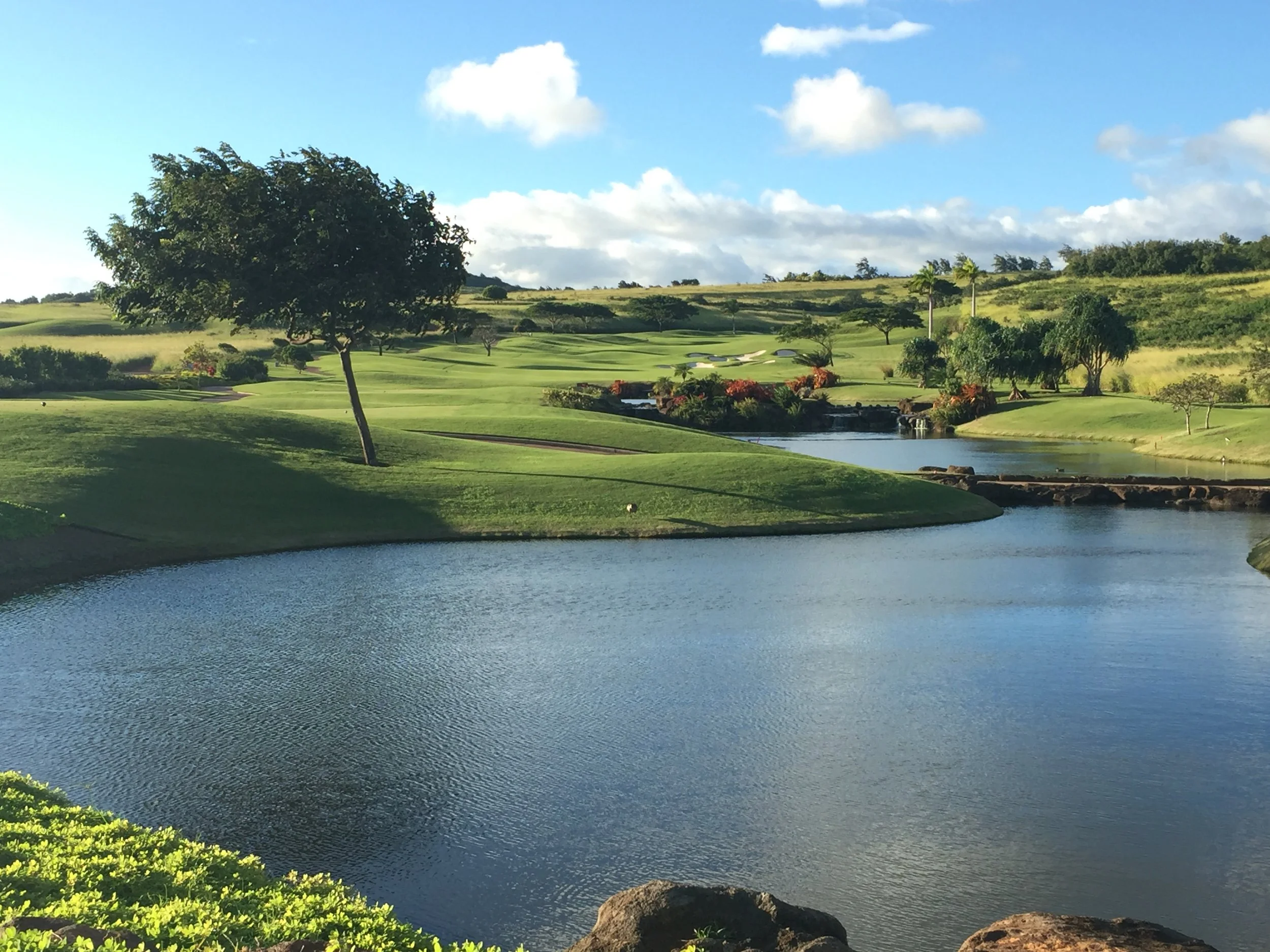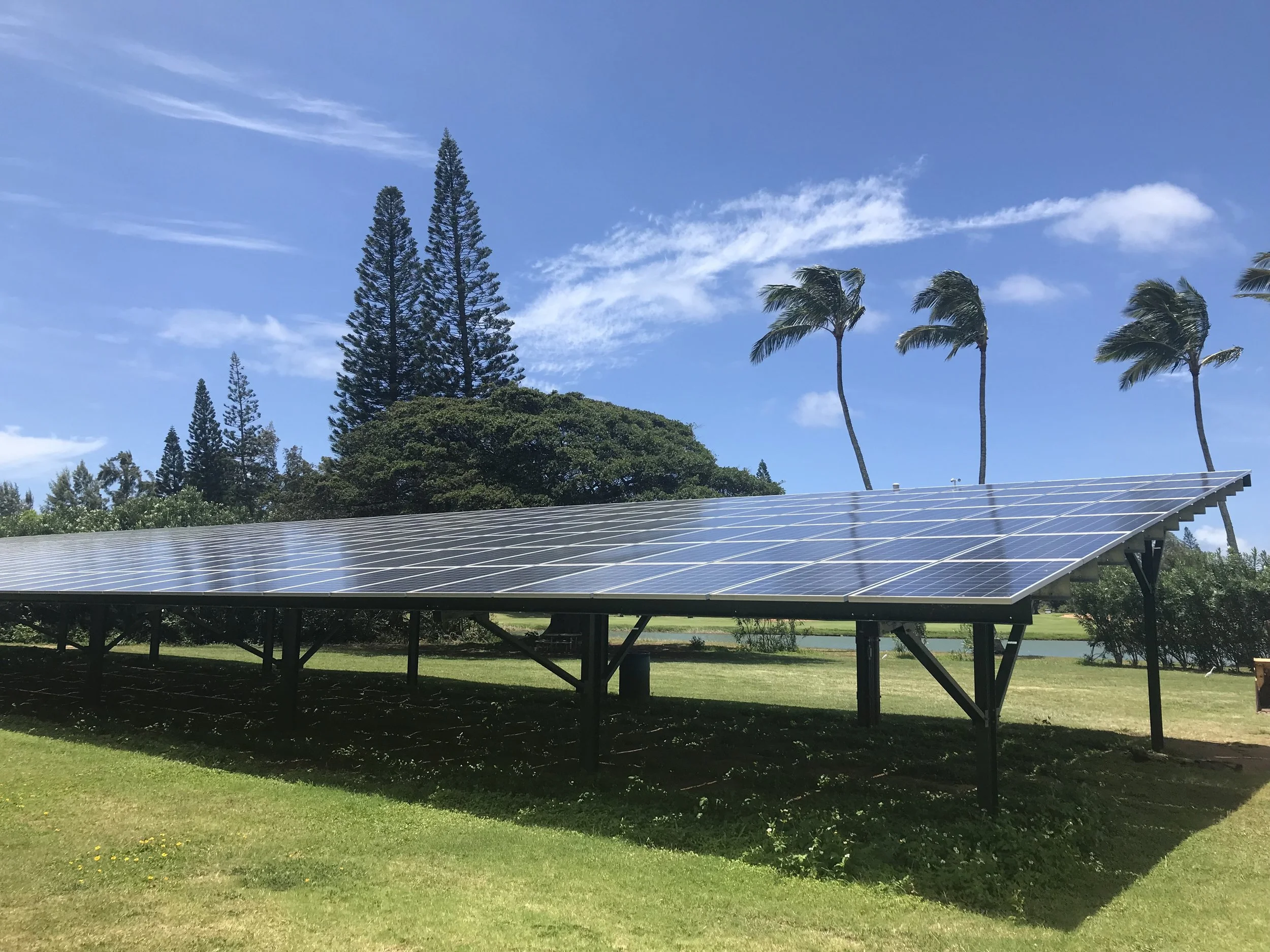6 - Surface Water Management & Water Quality

Golf courses provide acres of green space helping to reduce the urban heat island effect, providing surface water filtration, and supporting habitat for wildlife and ecosystem function.
In Hawai’i, programs designed to protect surface water quality are administered by the Hawai’i Department of Health. The USDA Forest Service National BMP Program for water, which was developed to improve management of water quality consistently with the Federal Clean Water Act (CWA) and State water quality programs, also serves a great resource, in general. BMPs are specific practices used to reduce or control impacts to water bodies from nonpoint sources of pollution, most commonly by reducing the loading of pollutants from sources into storm water and waterways. BMPs can be applied before, during, and after pollution-producing activities to reduce or eliminate pollutants to receiving waters.
The Department of Land and Natural Resources, Commission on Water Resource Management (CWRM) will work with the contractor on required permits. CWRM regulates all ground water and surface water use. All appropriate Permits for well construction, pump installation and well abandonment need to be submitted to CWRM for approval (HAR 13-168-12). In event that the Well is located within a Water Management Area, a Water Use Permit will also need to be obtained, only wells for domestic consumption are exempted from this requirement. If there is an existing well, these contractors are licensed (as indicated above) to investigate and facilitate maintenance.
IDENTIFICATION
It is important to identify and explore your watershed. You can find your watershed by zip code at http//cfpub.epa.gov/surf/locate/index.cfm. Another easily accessible reference can be through using Google Earth’s digital aerial satellite view. Identify the nearest major river to your location. If a stream or creek is not present, consult a map for the names of local streams and look downslope where water from your land drains. A good clue may be the nearest bridge.
Trace your local stream to its closest outlet point and then follow it to its final destination - the major river or other water body into which it drains. Evaluate your impact and take steps to reduce pollution. What you do can affect water quality both on and off-site.
Once the watershed is identified, check the HDOH to see if there is a watershed plan for it: https://eha-cloud.doh.Hawai’i.gov/cwb/#!/watershed-based-plan/list. Watershed plans may include golf course management recommendations. If a golf course is located in a watershed with a watershed plan, it may be eligible to receive federal funding (through the CWA) to implement BMPs to protect water quality.
Regulations
Understand federal, state, and local regulations regarding water quality and management. Hawai’i regulations include:
Water Quality Standards (Hawai’i Administrative Rules Title 11, Chapter 54)
Water Pollution Control (Hawai’i Administrative Rules Title 11, Chapter 55)
Total Maximum Daily Loads (Clean Water Act Section 303(d))
Statewide Storm Water Principles (SSWMP) www.stormwaterHawai’i.com
Clean Water Act Sections 404 and 401
Water Resource and Protection Plan (WRPP) - while not a regulation, the Hawai’i Water Plan is the master water plan for the state and consists of the WRPP, the Water Quality Plan, and other state and county water plans. It is required by the State Water Code (Hawai’i Revised Statutes §174C)
PLANNING & MANAGEMENT
Erosion Control During Construction
Erosion and sediment control (E&SC) is a term used in the construction industry, related to storm water runoff at a project’s site. The website www.stormwaterHawai’i.com breaks down the term to demonstrate how erosion control measures prevent wind and water soil erosion at a construction site, while sediment controls are designed to capture eroded soil within a site.
Develop a Storm Water Pollution Prevention Plan (SWPPP)
A SWPPP is required by the construction general permit and helps prevent storm water pollution. State requirements for SWPPPs can be found in Hawai’i Administrative Rules §11-55, Appendix C. The SWPPP is more than a sediment and erosion control plan; it describes all construction site operator activities to prevent storm water contamination, control sedimentation, and comply with requirements of the Clean Water Act.
Establish Source Control Practices
Source control practices should prevent pollution by limiting or reducing potential pollutants at their source, which involve keeping a clean, orderly construction site. These practices involve day-to-day operation of the site and are usually controlled by the contractor. This should include establishing water quality buffers and special management zones. Water quality buffers consist of drain lines and special management zones include a series of vegetative filtration buffers such as a 25 foot turf swale, followed by a 25 foot native area, and finally a sheet flow to an undisturbed forest area. Special management zones are more clearly defined in the next section as a “Storm Water Treatment Train”, in which water is conveyed from one treatment to another by conveyances that themselves contribute to the treatment.
Not all storm water on a golf course originates there; some may be from adjoining lands, including residential or commercial developments. The golf course serves as an important community resource for filtration. Storm water control involves more than preventing flooding of facilities and play areas, including:
Controlling amount and rate of water leaving the course
Storing irrigation water
Controlling erosion and sediment
Enhancing wildlife habitat
Removing waterborne pollutants
Addressing aesthetic and playability concerns
Establish a Storm Water Capture Train
A storm water “treatment train” approach conveys water from one treatment to another, filtering or treating water at each stage. It incorporates at least two processes to maximize control of pollutants from runoff. A successful treatment train will help eliminate or minimize as much directly connected impervious area (DCIA) as possible. A common treatment train includes turf swales on side slopes designed to filter and slow down the movement of storm water, the second car in the train includes a swale or main channel that directs storm water to the final car in the train, often a constructed wetland. Vegetated swales slow and infiltrate water and trap pollutants in the soil, where they can be destroyed naturally by soil organisms. Depressed landscape islands in parking lots can catch, filter, and infiltrate water, instead of letting it run off. When hard rains occur, an elevated storm water drain inlet allows the island to hold the treatment volume and settle out sediments, while allowing the overflow to drain away.
Additional measures include maximizing use of pervious pavements, such as brick or concrete pavers, separated by sand and planted with grass. Special high-permeability concrete is available for cart paths or parking lots. Also, disconnect runoff from gutters and roof drains from impervious areas, so that water flows onto permeable areas, allowing it to infiltrate near the point of generation.
Storm water treatment train (Source: BMPs for NY State Golf Courses)
Establish Erosion & Sedimentation Control Practices
Erosion prevention practices may include ground covers such as vegetation, riprap, mulch, and blankets that absorb the energy of a rain drop’s impact and reduce erosion. Also included are BMPs such as swales and ditches that divert water around a site to prevent contact.
Sedimentation control should include installation of erosion control barriers between planned turfed areas and streams or ponds. Barriers may include silt fencing and sedimentation ponds. Locations should be determined and shown in the erosion control plan. These erosion control measures should remain in place until turf matures.
Water Quality Monitoring & Testing
A water quality monitoring program must include monitoring surface water, groundwater, and pond sediments. It should be implemented in three phases: background, construction, and long-term management. A complete water analysis is recommended on all waterbodies onsite to establish a baseline and identify any issues. Sampling should occur four to six times per year - at a minimum, twice during dry periods and twice during wet periods.
Surface water sampling may include irrigation lake, pond, wetlands, or anchialine pools within golf course boundaries. Groundwater samples should include sites located near the ingress and egress ends of the golf course, in addition to wells for golf courses near the coast. Obtaining water samples from the same location is important to establish a baseline and so comparisons can be made. Sample locations should be identified on maps, and photographed so they are easily located during subsequent sampling. The objective is to maintain required water quality standards.
Field analyses should include pH, water temperature, specific conductance, and dissolved oxygen
Laboratory analyses should include chlorophyll a, total nitrogen, nitrate-nitrite nitrogen, ammonia-nitrogen, total phosphorus, orthophosphate, silica, total dissolved solids, and turbidity
Pesticide analyses should identify if there is a presence of pesticides from past land use
All ponds, streams, wetlands, and anchialine pools should be inspected twice annually, once in the spring and once in autumn. Inspections should focus on examining vegetation, color and clarity of surface waters, and water quality. In conjunction with inspections, vegetated buffer strips should be inspected for debris, integrity of vegetative cover, and existence of channels or other indicators of concentrated storm water flow. Contact your local regulator for additional advisement.
Protecting Environmentally Sensitive Areas
Riparian buffers and wetlands can provide long-term pollutant removal capabilities without the comparatively high costs associated with constructing and maintaining structural controls. Preservation of these areas is important to protect the water quality of streams, wetlands, lakes, anchialine pools, coastal zones, and reservoirs. Land acquisition programs help preserve critical areas for maintaining surface water quality.
Adequate buffer strips along streambanks provide protection for stream ecosystems, help stabilize the stream, and can prevent erosion. Buffer strips can also protect near-stream vegetation that minimizes the release of sediment into stream channels. Levels of suspended solids have been shown to increase at a slower rate in stream channel sections with well-developed riparian vegetation.
Buffers around the shore of a waterbody, or other sensitive area, filter and purify runoff as it passes across the buffer. Plant buffers with native species can provide a triple play of water quality benefits, pleasing aesthetics, and habitat/food sources for wildlife. It is important to continue plantings into the water to provide emergent vegetation for aquatic life, even if the pond is not used for storm water treatment. Maintain vegetative conditions and practices established during construction, these include:
Herbaceous composition of buffer filter strips (buffers with native species provide a triple play of water quality benefits)
Mow herbaceous cover of buffer filter strips twice per year
Remove cut material by hand
Remove damage to existing topography and ground cover conditions, including siltation, erosion, and compaction or trampling by golfers. Accumulated silts should be removed, eroded channels filled, and compacted areas should be raked. All repairs should be conducted using hand tools only, unless a mechanical tool “arm” can reach into the wetland to perform a task. Damaged groundcover vegetation should be restored by seeding or planting, depending on the vegetation damaged. Channels which form within the filter strips should be filled and immediately reseeded. Grading may be necessary to prevent reformation of the channel and to restore sheet flows. Trash, golf balls, and other debris should be removed from buffers.
Wetland Protection
In general, wetlands in Hawai’i vary substantially from wetland environments found in the continental United States. The islands’ small size, relatively steep topography, and unique soils and microclimates engender different types and distributional patterns of wetlands than those on the mainland. For example, Hawai’i tends to have fewer lakes, reservoirs, deep ponds, and other large-scale lacustrine systems typically associated with areas of flat topography. Hawai’i also has 148 anchialine pond sites located in coastal areas. Today, Hawai’i’s wetlands comprise approximately 110,800 acres.
Several considerations should be observed when establishing or maintaining wetlands:
Wetlands should be established where water enters lakes to slow flow and trap sediments
Appropriate resources should be applied to maintain silt fencing
Employ BMPs on projects upstream to prevent erosion and sedimentation; natural waters should not be considered treatment systems and must be protected (natural waters do not include treatment wetlands)
Establish low – to – no maintenance level within a 75-foot buffer along non-tidal and tidal wetlands
Establish and maintain 100-foot riparian buffer around wetlands, springs, spring runs
References for further information:
Protection of wetlands: http://water.epa.gov/polwaste/nps/wetmeasures/upload/2005_08_19_NPS_wetmeasures_ch4. pdf
Restoration of wetlands: http://water.epa.gov/polwaste/nps/wetmeasures/upload/2005_08_19_NPS_wetmeasures_ch5. pdf
Vegetated treatment systems: http://water.epa.gov/polwaste/nps/wetmeasures/upload/2005_08_19_NPS_wetmeasures_ch6.pdf
Designing an Aquatic Plant Management Strategy
According to the Aquatic Ecosystem Restoration Foundation, the extensive damage caused to many aquatic ecosystems by invasive and nuisance aquatic plant species in the United States has been well documented...managers can employ a variety of practices to assist in restoring these aquatic ecosystems to health, including biological, mechanical, cultural, and chemical methods. These methods have been extensively researched over the last several decades and results have shown the benefits of combining more than one technique. Collecting and reviewing these practices for a specific site is one of the first steps in formulating an integrated control strategy.
Properly designed ponds with a narrow fringe of vegetation along the edge are more resistant to problems than those with highly maintained turf. In ponds with littoral plantings, problem plants should be selectively controlled without damaging littoral shelves. It’s frequent practice to remove filamentous algae by hand and/or frequently apply algaecide to small areas of algae (spot treatment). Superintendents should encourage clumps of native emergent vegetation at the shoreline, plus use ecosystem, watershed, and cost-benefit perspectives to determine long-term management strategies. Practice and develop an ongoing system of integrated control methods that include mechanical, cultural, biological, and chemical BMPs as needed.
Regularly assess results of invasive weed control programs (including quantitative documentation of results from control strategies) and re-evaluate management options as part of a professional plant management strategy.
EDUCATION
Education should be conducted on multiple levels, including communications and procedures for construction staff, golf course maintenance crews, and members/guests. Develop an education program for construction staff to create a common vision around the SWPPP. Include signage and communications for members and guests to identify and provide education regarding environmentally sensitive areas. Educate managers and the public about the importance of protecting water resources from invasive weeds to maintain healthy water quality and fish and wildlife habitat. Education promotes proper operating procedures, heightened awareness, and environmental stewardship.























